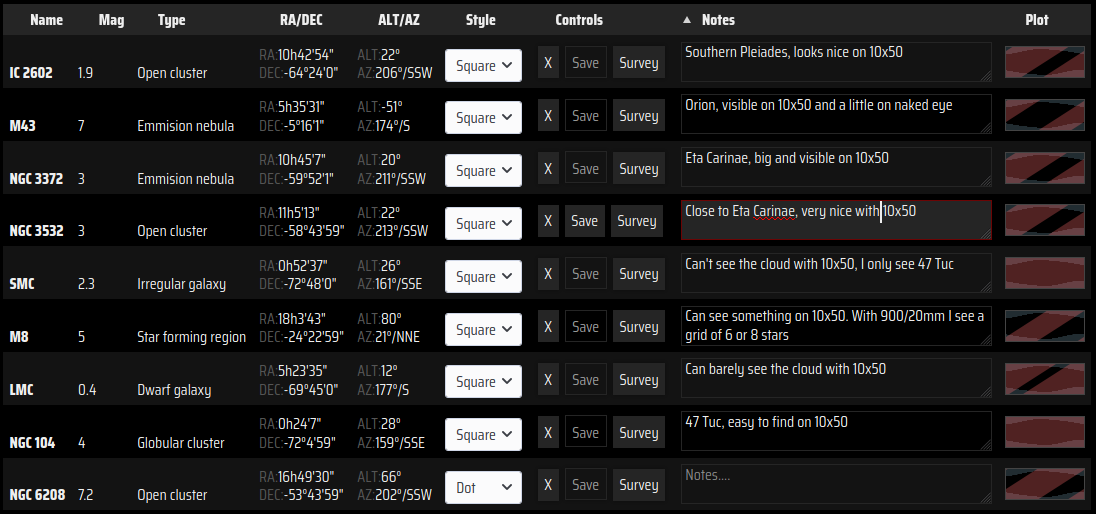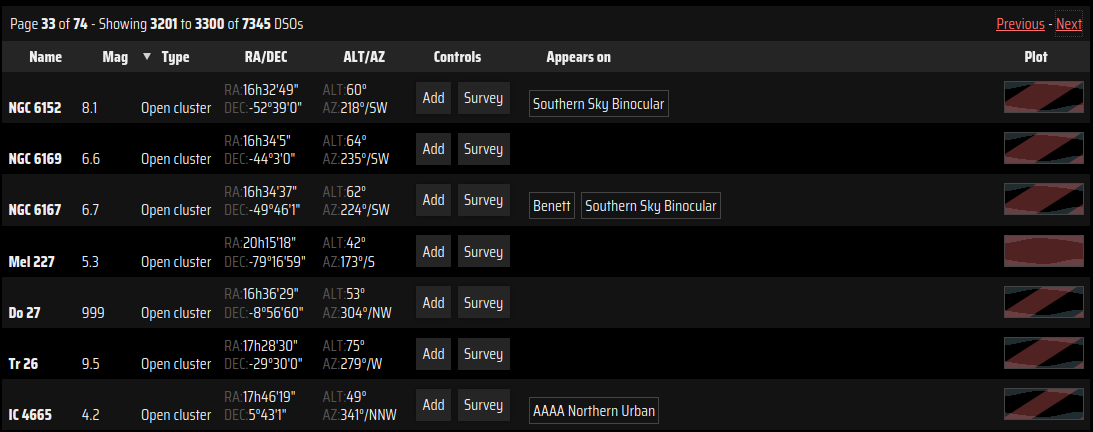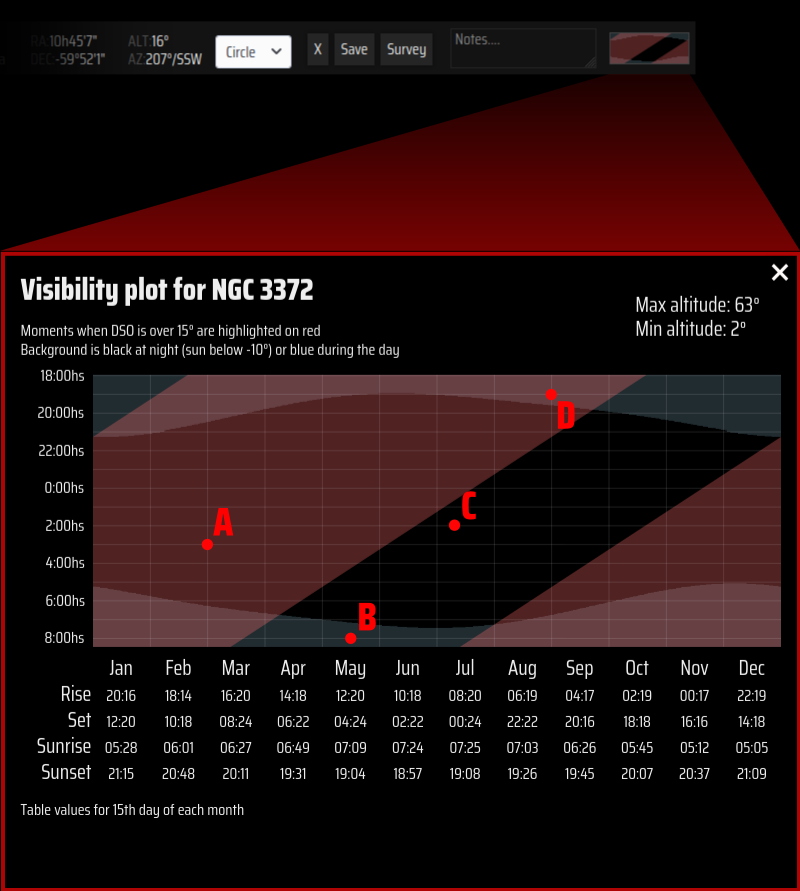Introduction
What does DSO (Deep-Sky Object) mean?
It is something you can see on the sky using binoculars or a telescope. "Deep" means that the object is outside of the solar system.
Examples of what DSOs are:
- Galaxies
- Nebulas
- Clusters of stars
Examples of what DSOs are not:
- Single stars
- Planets
- Moon, Satellites
Why we made this application?
There are lots of interesting things to look in the sky, and you can already find different well-suited applications to discover them.
This is a list of things you can see, ordered from easy to hard, and including software recommendations:
- Planets or moon: Stellarium or mostly anything.
- Artificial satellites: Heavens-Above, ISS-Detector.
- Deep-Sky Objects: This application, see more alternatives below.
- Meteor showers: timeanddate, NASA website.
We think that discovering observable DSOs can be hard, there are a lot of articles with "The top 15 Deep Sky Objects for beginners", "Brightest astronomy targets for binoculars and telescopes" or "Top 50 southern night sky objects for small telescopes". But we find cumbersome to look at those articles: Some objects have different names on different lists, and visibility depends on the month of the year and on your location.
DSO Guide tries to gather everything in one place, helping to find what you can see from your date and location. We are trying to answer questions like:
- What are the brightest DSOs?
- Can I see it from my location?
- On which months I can see this?
- Where can I find it tomorrow at 11PM?
- What the hell is NGC 3532 and how does it look?
Alternatives
- Telescopius: This is the best alternative, make sure to check it too.
- Stellarium: Useful when you know what you want to see. Also has some catalogs on the Search window ("Lists" tab).
- DSO Planner: An Android application that can be useful.
It is impossible for us to make something that replaces all of those programs, but we hope you find DSO Guide as good complement for them.
Using this application
Header
On the top of the page you can register or login. Having an account is optional, with it you can store your location and DSO watchlist.
Settings
There you can select:
- Time and date.
- Your location: enter your coordinates or select from a map.
Sky Chart
This circle shows the sky on the selected time and location. Objects added to the watchlist will be shown on this chart automatically if they are above the horizon.
Watchlist

This is your personal list of DSOs, these will be shown on the Sky Chart and on the Sky Survey window. If you are logged in they will be remembered for next login.
Columns available on the table:
- Name: Some objects can have more than one name, but this field generally shows the Messier, NGC or IC names.
- Magnitude: A smaller number means that the object is brighter.
- Type: The type of object, being a galaxy, nebula, star cluster, etc.
- RA/DEC: Shows the Right Ascension and Declination coordinates of the object.
- ALT/AZ: The altitude above the horizon and the Azimuth. It depends on the time and location chosen.
- Style: Icon to use when showing the object on the Sky Chart or Sky Survey window.
-
Controls:
- Delete the object from the watchlist, you can still find it on the catalog.
- Save changes made to the object on the server. Necessary if you changed the style or the notes and you want those to be available on next login.
- Survey: Opens the Sky Survey window where you can see images from the object.
- Notes: Here you can write information about the object so you can remember if you have already seen it, how, when, etc.
- Plot: Shows the Visibility Plot of the object, see below for more information.
Click the "Filters and Settings" button to show a search field. Moreover, you can also sort the table by clicking column headers.
Catalog

Contains the list of every DSO known by this application. We call it the DSO Guide Catalog, but it contains objects from different catalogs. Catalogs are popular lists of DSOs, there are a lot of them. We tried to gather a few so you can easily find popular DSOs.
For every object on the DSO Guide Catalog you can see the same information already available on the Watchlist table, but also:
- A button to add the object to the Watchlist.
- A column named "Appears on", this column shows the list of catalogs that contain this object.
You can guess that objects included on many catalogs must be popular, so make sure to check objects with lots of entries on "Appears on". At the same time take a look at the Altitude column, or better, take the time to understand the plot to determine of you can observe it.
Try the Filters and Settings dropdown. For example you might want to filter only objects in the "Southern Sky Binocular" Catalog. Also you can search objects by name.
Visibility plot

Every object on the watchlist or catalog has a small miniature of the plot, click it to see a popup.
This is perhaps the most unique and difficult to understand feature this program has. It allows you to see at first glance lots of information:
- Is the object ever visible on my location?
- Does the object ever reach a high altitude or is it always really low over the horizon?
- Can I always see it or only on some months?
- On which months can I see this object at evenings?
- On which months can I see this object before sunrise?
You can see a DSO if it is over the horizon and if at the same time the Sun is below the horizon (i.e. during the night). This plot helps you to find when that happens in the span of a year.
The vertical axis has the time of the day in hours, and the horizontal axis shows the day or month. On the screenshot above, points labeled A, B, C and D were added for explanation purposes. See how each point represents an hour on a particular day of the year:
- A: March 1st at 3:00hs
- B: May 15th at 8:00hs
- C: July 10th at 2:00hs
- D: September 1st at 19:00hs
The background of the plot is black, but on some parts it has a blue or red paint over it. If at some point the plot has a blue background it means that the sun is over the horizon (i.e. it is daytime). If at some point the plot has a red background, it means that the DSO is over the horizon. Now take a look what happens at A, B, C and D:
- A: March 1st at 3:00hs. The DSO is visible, because it is over the horizon and the sun is hidden.
- B: May 15th at 8:00hs. It is daytime, and the DSO is below the horizon.
- C: July 10th at 2:00hs. It is nighttime but we can't see the DSO because it is below the horizon.
- D: September 1st at 19:00hs. The DSO is over the horizon but we can't see it because it is daytime.
Note: The background is painted blue during the day. Actually we consider daytime when the sun is higher than -10°, because that's roughly when twilight starts/ends. Similarly, the background is red when the DSO is higher than 15° over the horizon, otherwise buildings/trees/light pollution might block the view.
That way, by looking at different points you can deduce if the object is visible on a given moment. Now ignore the points, by looking at the background you can deduce:
- On January, the DSO is visible all the night.
- On September, the DSO is visible only one or two hours just after sunset and before sunrise.
- I never stay awake past 1:00am. In that case, the best months to see it are roughly from January to July.
- Nights are longer from July to August, during Winter, so I live on the Southern Hemisphere.
Below the plot you can also see the rise and set times for the sun and the DSO. This information can be approximately infered from the plot.

The interesting thing is that you can look at the plot miniatures of objects on the catalog and guess lots of things without opening the plots:
- NGC 884 is never visible.
- M31 is visible maybe during only half an hour. This means that it does not rise far over the horizon.
- IC 2602 is almost always visible. During September/November only after midnight.
- M41 is visible during the first and last months of the year. I don't like staying up late so better look at it from January to June. If I wan't to do guided astrophotography, I can leave the camera shooting all night only during December.
